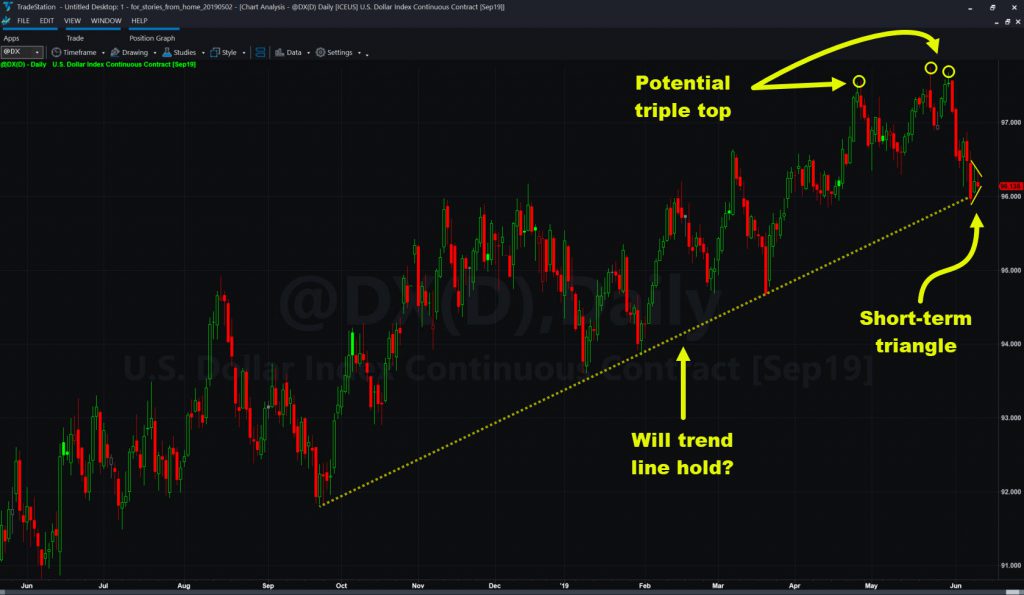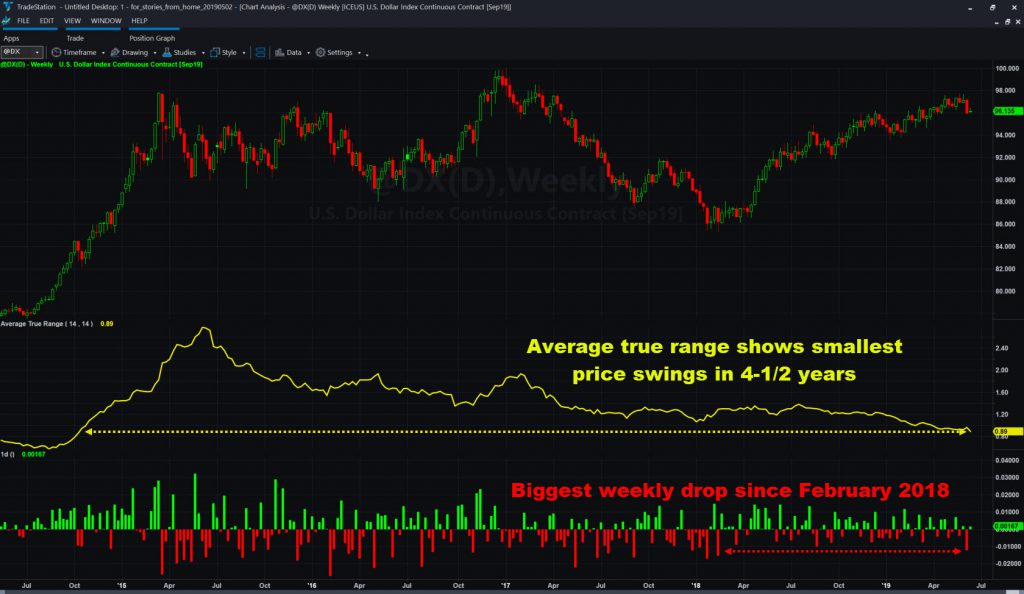The U.S. dollar seems to be teetering before some events with the potential to drive it lower.
The U.S. dollar index (@DX) has spent most of 2019 between 95 and 97.75. It broke down quickly from those highs in early June and is now squeezing into a potential triangle. It also just had its biggest percentage drop in over a year.
Chart watchers may consider that kind of price action as bearish — especially because it followed an apparent triple-top failure at the top of the range between late April and late June.

The movement on the chart comes before a potentially huge Federal Reserve meeting next Wednesday, June 19. As most readers probably know by now, the central bank shifted from a rate-hiking stance to a no-change position between late 2018 and early this year. Now in recent weeks, policymakers have moved all the way toward rate cuts.
Forces Working Against the Dollar
At least three forces are at work. First, inflation remains low despite years of steady job growth. That gives the Fed less reason to raise rates.
Second — and most importantly — other central banks around the world are cutting rates or moving in that direction: Australia, India, Europe, Japan, etc. The Fed cannot ignore that trend without creating a potential currency crisis.
Third, President Trump has put these pieces together to hammer the American central bank. He complained as policymakers hiked rates last year, and this week called their actions “a mistake.”
“They don’t have a clue,” he tweeted on Tuesday morning. “The United States has VERY LOW INFLATION.”
Here Comes the Fed
Most experts think the Fed will wait until July 31 to cut rates, although CME’s FedWatch tool still sees a 20 percent chance of a reduction next week. The main focus will be on Chairman Jerome Powell’s mini-speech and press conference after the June 19 meeting. How aggressively will he signal a move the following month? Is October in the cards as well? He’ll be a rockstar that day.
Global trade is the other big item with the G20 meeting in Osaka on June 28-29. The market wants to know whether Chinese President Xi will attend after President Trump threatened him with more tariffs should he skip. This one is harder to anticipate because the news could come at any time.

A headline confirming Xi’s presence would almost certainly be viewed as bullish for global assets and thus bearish for the U.S. dollar. The opposite would be true if he takes a hard line against Washington.
How Traders May Play It
One direct way traders can react to a move is buying euro futures (@EC), which is similar to selling @DX.
Another response would be to buy gold futures (@GC) because they typically move in the same direction as @EC. (Because gold is priced in dollars, a cheaper greenback often means more expensive gold.)
A handful of global stocks and exchange-traded funds that may move with @DX are also be on the short list for traders to watch:
- iShares MSCI emerging-markets (EEM): Heavily traded emerging-market ETF 54 percent exposed to China, Korea and Taiwan.
- iShares China ETF (FXI): Pure China play.
- Alibaba.com (BABA): The Chinese e-commerce juggernaut is also one of the most actively traded stocks in the U.S.
- Apple (AAPL): China is a make-or-break market for the iPhone maker. Trade war bad, no trade war good!
In conclusion, currencies like the dollar have been incredibly boring for years. But that could change soon. Hopefully this post helps you prepare in case things start moving again.























